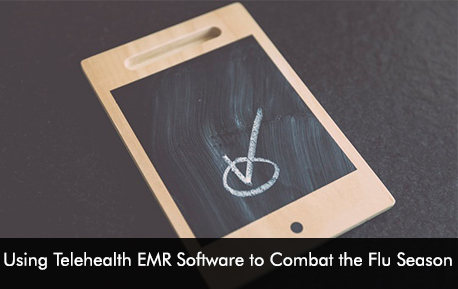Telemedicine EMR software solutions and virtual sessions are helping to keep patient and hospital staff members safe. With the flu season around the corner hospital systems and providers are cautious to prevent patients with cough, cold, and flu symptoms from walking into the hospital facility. Healthcare providers are turning to telehealth solutions to diagnose and treat patients with the flu virus. By providing care remotely the burden on urgent care centers can decline and a reduction in in-person visits can also help to reduce exposure for staff members and doctors.
Why is telehealth an effective platform to combat the flu season?
Doctors and physicians can use the telehealth platform to treat and diagnose patients by looking at the two most common symptoms of flu which include cough and fever. Remote sessions via HD video consultations are effective and can help physicians provide prompt care to patients of every age and covering a wider population group. Through telemedicine EMR software functionality doctors can also send prescriptions remotely saving both time and money for the patient. Virtual care is the answer to limit exposure and the spread of the flu and cold virus. Providers encourage sick patients to stay at home and seek remote care services instead of driving down to the doctor’s clinic. By preventing face-to-face and in-person sessions with the doctors the spread of the virus can be limited and high-risk populations are safer. The doctor can see patients at a distance and provide the cure they need from the comforts of their homes. According to the American Hospitals Association, more than half of US hospitals (67%) use telehealth software solutions to connect with patients remotely. The telemedicine solutions are seen as a flexible, manageable, accessible, and affordable option for patient populations.
The care process can drastically enhance as doctors can use the telemedicine platform to manage a patient’s historical data. The patient history and analysis feature in the software system supports effective treatment for the patient. Telehealth also expands the doctor’s reach and enables them to see more patients remotely. Patient communities who can’t visit the doctor’s clinic due to disability, old age, or geographical limitations can easily receive the best care from their roof. Usually, these communities have a smartphone and internet connectivity which is required for a telemedicine session.
A smart telehealth strategy can also help to increase productivity levels and reduce overall physician burnout. With the COVID-19 pandemic and the flu season, providers can be strained and stressed but telemedicine supports quick and effective diagnosis and help in these trying times.
Moving ahead
Flu does not only makes one feel miserable but is also dangerous in the United States. Saying that the flu season can get safer through telemedicine technologies by limiting exposure to the virus and proving opportunities for rapid remote care. Telehealth plays a key role in reducing the impact of the flu outbreak and helps to monitor and protect the health of larger patient population groups. The virtual consultations can also be used as a source of patient education and communication helping them to prevent catching the virus by letting them know about the benefits of flu vaccinations and basic hygiene regime, patient safety can also improve.







